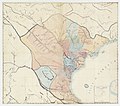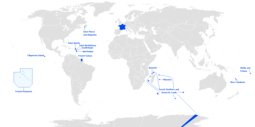Tonkin (French protectorate)
Protectorate of Tonkin Protectorat du Tonkin Xứ bảo hộ Bắc Kỳ (處保護北圻) | |||||||||||||||||||
|---|---|---|---|---|---|---|---|---|---|---|---|---|---|---|---|---|---|---|---|
| 1883–1945 1945–1948 | |||||||||||||||||||
 Colonial ensign
| |||||||||||||||||||
| Motto: Liberté, égalité, fraternité" "Liberty, Equality, Fraternity" | |||||||||||||||||||
| Anthem: "La Marseillaise" | |||||||||||||||||||
 Administrative divisions of Tonkin 1920 | |||||||||||||||||||
| Status | Protectorate of France (1883-1887) Constituent territory of French Indochina (1887-1948) | ||||||||||||||||||
| Capital | Hanoi | ||||||||||||||||||
| Common languages | French, Vietnamese, Central Tai languages, Southwestern Tai languages, Hmongic languages, Mienic languages | ||||||||||||||||||
| Religion | Mahayana Buddhism Confucianism Taoism Catholicism Folk religion | ||||||||||||||||||
| Demonym(s) | Tonkinese | ||||||||||||||||||
| Government | Absolute monarchy under colonial administration | ||||||||||||||||||
| Resident-Superior | |||||||||||||||||||
• 1886 | |||||||||||||||||||
• 1947-1948 | |||||||||||||||||||
• 1886 | (first) | ||||||||||||||||||
• 1888-1897 | Hoàng Cao Khải (last) | ||||||||||||||||||
| Historical era | New Imperialism | ||||||||||||||||||
| 1883 | |||||||||||||||||||
| 6 June 1884 | |||||||||||||||||||
| 22–26 September 1940 | |||||||||||||||||||
| 25 August 1945 | |||||||||||||||||||
• Disestablished | 1948 | ||||||||||||||||||
| Population | |||||||||||||||||||
• 1885 | 7,487,000[1] | ||||||||||||||||||
• 1939 | 11,509,000[1] | ||||||||||||||||||
| Currency | Vietnamese cash, French Indochinese piastre | ||||||||||||||||||
| |||||||||||||||||||
| Today part of | Vietnam | ||||||||||||||||||
Tonkin (Chữ Nôm: 東京), or Bắc Kỳ (北圻), was a French protectorate encompassing modern Northern Vietnam. Like the French protectorate of Annam, Tonkin was still nominally ruled by the Nguyễn dynasty but in 1886 the French separated Tonkin from the Nguyễn imperial court in Huế by establishing the (经略使, Kinh lược sứ).[2] However, on 26 July 1897 the position of Viceroy was abolished officially making the French Resident-Superior of Tonkin both the representative of the French colonial administration and the Nguyễn dynasty court in Huế giving him the power to appoint local mandarins.[2] In 1887 Tonkin became a part of the Union of Indochina.
In 1945 the Bảo Đại Emperor rescinded the Patenôtre Treaty ending the French protectorates over Annam and Tonkin creating the Empire of Vietnam, a Japanese puppet state.[3] Following the surrender of Japan ending World War II the Việt Minh launched the August Revolution which led to the abolition of the Nguyễn dynasty and the Proclamation of Independence of the Democratic Republic of Vietnam.
Tonkin was briefly occupied by the Chinese before being returned to France, causing the French to clash with the Việt Minh over control of the territory. In 1948 Tonkin and Annam were officially merged under the Provisional Central Government of Vietnam.
Establishment[]
After helping to unify Vietnam under the Nguyen Dynasty, the French Navy began its heavy presence in the Mekong Delta and later colonised the southern third of Vietnam including Saigon in 1867. Central Vietnam later became the French protectorate of Annam and French influence in the Indochina Peninsula strengthened. During the Sino-French War (1884–85), the northernmost part of Vietnam, Tonkin (then considered a crucial foothold in Southeast Asia and a key to the Chinese market) was invaded by the French. After the Treaty of Tientsin, all of Vietnam was governed by the French.
During the French colonial administration, Vietnam was administratively divided into three different territories: Tonkin (in the north), Annam (in the centre), and the colony of Cochinchina (in the south). These territories were fairly arbitrary in their geographic extent as the vast majority of the Vietnamese regarded their country as a single land and minor resistance to French rule continued over the next 70 years to achieve an independent state. Annam and Tonkin were originally a single entity, the Résidence supérieure of Annam-Tonkin. On June 3, 1886, the Nguyễn Emperor Đồng Khánh delegated all of his powers in Tonkin to a Kinh lược sứ (经略使, equivalent of Viceroy), who acted under French supervision. On May 9, 1889, the Résidence supérieure of Annam-Tonkin was abolished, with Annam and Tonkin being separated in two Résidences supérieures, each subordinated to the Governor-General of French Indochina. On July 26, 1897, Governor-General Paul Doumer had Emperor Thành Thái abolish the post of Kinh lược sứ. Also the Nguyễn dynasty still nominally reigned over Tonkin, it was now de facto under direct French rule.[4]
During French rule, Hanoi was made capital of Tonkin and, in 1901, of the whole French Indochina. Cities in Tonkin saw significant infrastructure and economic development under the French, such as the development of the port of Haiphong and construction of the Trans-Indochinois Railway linking Hanoi to Saigon. Under French economic plans, mines yielding gold, silver, and tin as well as the farming of rice, corn, and tea powered Tonkin's economy. The imports included rice, iron goods, flour, wine, opium and cotton goods. Industrialization later led to the opening of factories producing textiles and ceramics for export throughout the French Empire. French cultural influence on Tonkin was also significant as French became the primary language of education, government, trade and media and heavy Catholic missionary activity resulted in almost 10% of the population identifying as Catholic by the 1940s. Prominent buildings in Hanoi were also constructed during the period of French rule, such as the Hanoi Opera House and the Hanoi University of Technology.
Administration[]


Girls study chemistry in colonial school (Ecole Normale d'Institutrices).

Girls study tailoring in colonial school (Ecole Normale d'Institutrices).

Girls study maths in colonial school (Ecole Normale d'Institutrices).

Girls study drawing in colonial school (Ecole Normale d'Institutrices).

Bedrooms at school.

Play time
Tonkin was a component of French Indochina. It was a de facto French colony despite being a protectorate on paper. The British Naval Intelligence Division wrote during World War II that "at first the native political organization was maintained, but in 1897 the office of the viceroy, representing the king of Annam in Tonkin, was abolished, and since then other changes have further weakened the influence of the native government."[5] Tonkin was administered by a French resident similar to those in Annam, Laos, and Cambodia, but he had much greater authority because of the absence of any indigenous administration.[5][6] A conseil du protectorat composed of important officials and representatives from the chambers of agriculture and commerce, assisted the resident in performing his duties. There was also an advisory council made up of Vietnamese.[5]
On 31 July 1898 the President of France, Félix Faure, issued a decree that established a central bank for The entirety of French Indochina and that this bank would set the federal French Indochinese budget, on the same day the French president issued a decree that established a budget for the government of Tonkin.[7] Furthermore, the French president also decreed that the budget of Tonkin would be financed through direct tax revenue collected in the territory as opposed to only indirect taxes.[7] This decree also meant that the treasury of the Nguyễn dynasty was abolished and all finances to be directly managed by the French.[7] The Resident-Superior was assisted by various agencies such as the, the Tokin Protectorate Council, the Tokin Chamber of Commerce, the Tonkin Chamber of Agriculture, and the House of People's Representatives.[8] Despite its name the House of People's Representatives was not democratically elected but was composed of appointed Vietnamese elites and it only discussed issues related to taxation rather than legislation.[8]
Tonkin was made up of 23 provinces, subdivided into phu or huyen, cantons, and communes.[5] Local administration was in the hands of Vietnamese mandarins, although they were appointed by the resident rather than the emperor as in Annam.[5] The smallest unit of administration, the commune, was overseen by two councils: the toc bieu, and the mandarin-dominated ky muc with the authority to veto decisions of the toc bieu.[5] Hanoi and Haiphong had municipal councils appointed by the governor-general of Indochina.[5] Each province was headed by "Công sứ" (公使), a French Resident-Minister, who was also assisted by a number of different agencies such as the Resident-Minister's Office, the Provincial Council, etc.[8]
End[]
French colonial administration lasted until March 9, 1945, during Japanese occupation (1941–1945). Although French administration was allowed during Japanese occupation as a puppet government, Japan briefly took full control of Vietnam in March 1945 under the Empire of Vietnam and Tonkin became the site of the Vietnamese Famine of 1945 during this period.[9] At the end of the war, the north of Vietnam (including Tonkin) saw a sphere of influence by China while the south was briefly occupied by the British for French forces to regroup and regain control. Harry Truman at the Potsdam Conference, stated an intention to hand the region back to French rule, a sharp contrast to Franklin D. Roosevelt's strong opposition to colonialism and commitment to support the Viet Minh. However, after the Japanese withdrew from Vietnam, Ho Chi Minh proclaimed the establishment of the Democratic Republic of Vietnam in Ba Đình Square. Hanoi was later reoccupied by the French and conflict between the Viet Minh and France broke out into the First Indochina War.
As the French sought to establish a coherent government in Vietnam as an alternative to Ho Chi Minh, Tonkin was merged in 1948 into the Provisional Central Government of Vietnam, which was replaced the next year by the State of Vietnam, following the reunification with Cochinchina. After the French defeat at the Battle of Dien Bien Phu in Western Tonkin in 1954, the Communist state of North Vietnam was formed, consisting of Tonkin and northern Annam.
Gallery[]

Administrative divisions of Tonkin 1929

Tonkin 1930

Tonkin 1889-1895

Tonkin 1889-1895

Tonkin in the early 1900s

Tonkin in the 1880s

Tonkin 1894

Tonkin 1890

Tonkin 1889

Tonkin 1883

Tonkin 1883

Tonkin 1902

Tonkin 1891

Capture of Nam Định, 1883

French zouave officer in Tonkin, Spring 1885

Hanoi around 1910

The French General Gouvernor's Palace in Hanoi

Tonkin woman with black-painted teeth, ca. 1908
See also[]
- Tonkin
- List of administrators of the French protectorate of Tonkin
- List of French possessions and colonies
Notes[]
- ^ Jump up to: a b GDP of North and South Vietnam from 1800 to 1970, Davis, University of California, January 2000
- ^ Jump up to: a b Dommen, Arthur. The Indochinese Experience of the French, and the Americans, Nationalism and Communism in Cambodia, Laos, and Vietnam. Bloomington, Indiana: Indiana University Press, 2001. Page 23.
- ^ Việt Nam, Hội Khuyến học (November 17, 2011). "Mặt trận Tổ quốc Việt Nam: Chặng đường 80 năm vẻ vang". Dân trí.
- ^ Pierre Brocheux and Daniel Hémery, Indochine : la colonisation ambiguë 1858–1954, La Découverte, 2004, p. 78-81
- ^ Jump up to: a b c d e f g Naval Intelligence Division, 203–204.
- ^ Handler, Joseph (March 1943). "Indo-China: Eighty Years of French Rule". The Annals of the American Academy of Political and Social Science. 226: 131. doi:10.1177/000271624322600113. S2CID 144158566 – via SAGE.
- ^ Jump up to: a b c Thu Nhuần (tổng hợp) (July 28, 2016). "Nhà Nguyễn và những tháng 7 biến động. - Phải chăng tháng 7 với triều Nguyễn là một sự trùng hợp, khi Pháp mở đầu cuộc tấn công 1/9/1885 (nhằm vào 24/7/1858 âm lịch) và trận chiến đấu cuối cùng dưới sự lãnh đạo của triều đình nhà Nguyễn cũng diễn ra vào 5/7/1885" (in Vietnamese). Bảo tàng Lịch sử Quốc gia. Retrieved August 7, 2021.
- ^ Jump up to: a b c Pham Diem (State and Law Research Institute) (February 24, 2011). "The state structure in French-ruled Vietnam (1858-1945)". Vietnam Law and Legal Forum magazine, Vietnam News Agency - Your gateway to the law of Vietnam. Retrieved August 10, 2021.
- ^ L'Indochine française pendant la Seconde Guerre mondiale Archived February 5, 2012, at the Wayback Machine, Jean-Philippe Liardet
External links[]
![]() Media related to French protectorate of Tonkin at Wikimedia Commons
Media related to French protectorate of Tonkin at Wikimedia Commons



























